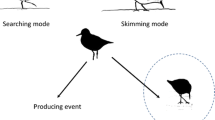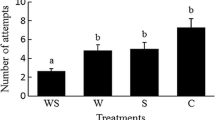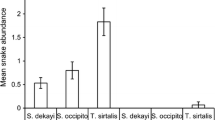Summary
Starlings were allowed to forage in patchy laboratory environments where patches contained either zero or a fixed number of prey. The condition of a given patch (prey or no prey) could only be determined from information gained while exploiting the patch. A starling's task was to determine to what extent to sample an apparently prey-less patch before giving it up as such, in a way which maximizes long-term energy intake rate. The simple model presented to predict the optimal sampling solutions was qualitatively but not quantitatively supported by the data. The main discrepancy was in the fact that an apparently prey-less patch should have been sampled to a fixed extent before leaving, whereas a distribution of sampling behavior was actually observed. The qualitative agreement was very good, however, as the modes of the observed sampling distributions often corresponded to the predicted optimal sampling solutions. Starlings seem to possess a patch-sampling ability which, at least for those simple situations analyzed, can lead to an efficient foraging strategy.
Similar content being viewed by others
References
Breck JE (1978) Suboptimal foraging strategies for a patchy environment. PhD dissertation, Michigan State University
Caraco T, Martindale S, Whittam TS (1980) An empirical demonstration of risk-sensitive foraging preferences. Anim Behav 28:820–830
Charnov EL (1976) Optimal foraging, the marginal value theorem. Theor Popul Biol 9:129–136
Green RF (1980) Bayesian birds: a simple example of Oaten's stochastic model of optimal foraging. Theor Popul Biol 18:244–256
Green RF (1984) Stopping rules for optimal foragers. Am Nat 123:30–40
Houston A, Kacelnik A, McNamara J (1982) Some learning rules for acquiring information. In: McFarland D (ed) Functional ontogeny. Pitman, London
Iwasa Y, Masahiko H, Yamamura N (1981) Prey distribution as a factor determining the choice of optimal foraging strategy. Am Nat 117:710–723
Krebs JR, Ryan JC, Charnov EL (1974) Hunting by expectation or optimal foraging? A study in patch use by chickadees. Anim Behav 22:953–964
Krebs JR, Stephens DW, Sutherland J (1983) Perspectives in optimal foraging. In: Brush AH, Clark GA (eds) Perspectives in ornithology. Cambridge University Press, Cambridge
Lima SL (1984) Downy woodpecker foraging behavior: efficient sampling in simple stochastic environments. Ecology 65:166–174
McNamara J (1982) Optimal patch use in a stochastic environment. Theor Popul Biol 21:269–288
Oaten A (1977) Optimal foraging in patches: a case for stochasticity. Theor Popul Biol 12:263–285
Sokal RR, Rohlf FJ (1981) Biometry, 2nd edn. Freeman, San Fransico
Stephens DW, Charnov EL (1982) Optimal foraging: some simple stochastic models. Behav Ecol Sociobiol 10:251–263
Author information
Authors and Affiliations
Rights and permissions
About this article
Cite this article
Lima, S.L. Sampling behavior of starlings foraging in simple patchy environments. Behav Ecol Sociobiol 16, 135–142 (1985). https://doi.org/10.1007/BF00295147
Received:
Accepted:
Issue Date:
DOI: https://doi.org/10.1007/BF00295147




